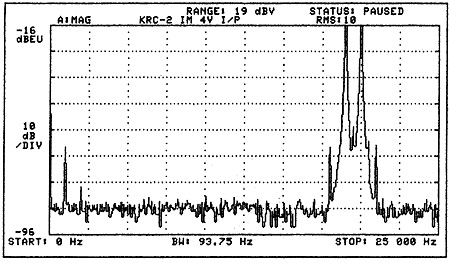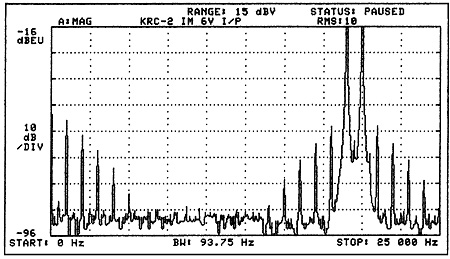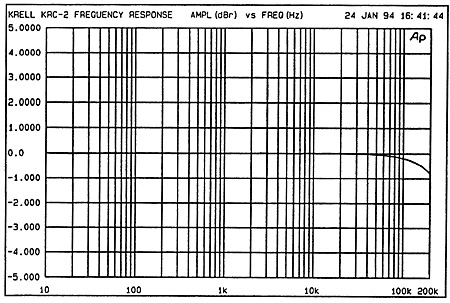| Columns Retired Columns & Blogs |
Krell KRC-2 line preamplifier Measurements
Sidebar 3: Measurements
The KRC-2's measured line-input input impedance was 50k ohms unbalanced, 100k ohms balanced. Though this is higher than earlier generations of Krell preamplifiers, it will reduce the loading on source components. The measured voltage gain was nearly twofold (5.45dB), increasing to fourfold (11.28dB) with the "gain" switch engaged. Over the 60dB operating range of the volume control, the channel balance was found to be generally better than 0.05dB. This is an excellent tolerance, defined by the use of precision discrete-resistor arrays. Balanced and unbalanced outputs matched to within 0.01dB (0.1%), promising good common-mode rejection ratios.
The line-input signal/noise ratio, both weighted and unweighted, was typically 100dB when referred to the standard IHF 500mV input level. Referred to a more typical 2V input, this Krell preamplifier's noise is a true 110dB or so down. Tight +0.015dB/–0.05dB limits sufficed for a wide and flat 15Hz–25kHz frequency response. With the specified +0, –3dB limits, the response ranged from near-DC, 0.2Hz, to greater than 300kHz. No RF or other additional ultrasonic filtering is present. However, the KRC-2 did not show any susceptibility to RF.
Interestingly, channel separation for the line inputs was poor. Separation was around 75dB in the midrange, dwindling to just 49dB at 20kHz. This figure was very sensitive to the source impedance used to drive the "silent" channel. Reducing the source impedance from 600 to 100 ohms on this channel improved the separation by 11dB.
Krell quotes better than 0.002% THD, –94dB, from 20Hz to 20kHz, but they do not specify the loading, input level, or output level used to reach this figure. With careful checking, I could reach no better than –84dB at 1kHz and –78dB at 20kHz.
A "soft" overload characteristic could be seen, with a gradual increase in distortion components observed for input levels over 2V. At 1V (unbalanced), the distortion was –80dB (0.01%) at low and mid frequencies. At 20kHz, the distortion increased to –73dB. Doubling the input level resulted in these figures all worsening by 10dB, while at 5V input (20dB above the nominal IHF 500mV level), the midband distortion was now –60dB, or 0.1%. The distortion hit –46dB (0.5%) at an input level of 6V RMS. While this level is high, it is not impossible with some D/A processors and pro gear.
I further explored the distortion performance of the line input using a 19–20kHz mixed tone. While the intermodulation was negligible with a 2V input level, at 4V the 1kHz component was beginning to kick up (fig.1); and at 6V, the whole harmonic IM series can be seen to be developing (fig.2). Fortunately, at moderate input levels this mild distortion was of low harmonic order, and therefore relatively benign, subjectively.

Fig.1 Krell KRC-2, HF intermodulation spectrum, DC–25kHz, 19+20kHz at 4V input level (linear frequency scale, 10dB/vertical div.).

Fig.2 Krell KRC-2, HF intermodulation spectrum, DC–25kHz, 19+20kHz at 6V input level (linear frequency scale, 10dB/vertical div.).
The KRC-2's maximum output level was 8V RMS (16V balanced), sufficient for any domestic application. Even when driven to its full 8V output level, the preamp's output was not affected by a tough 300 ohm load. The output impedance was a very low 12.2 ohms; the preamplifier is, in fact, powerful enough to drive a pair of sensitive moving-coil headphones to sensible sound levels. DC offset levels were below 1mV.—Martin Colloms

Fig.3 Krell KRC-2, line-stage frequency response (solid)(1dB/vertical div.). Stereophile June 1994, Vol.17 No.6
- Log in or register to post comments




































